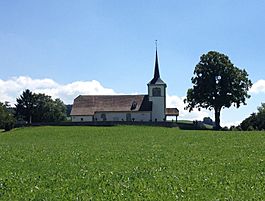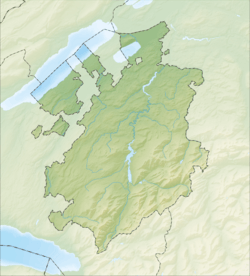Grangettes facts for kids
Quick facts for kids
Grangettes
|
||
|---|---|---|
 |
||
|
||
| Country | Switzerland | |
| Canton | Fribourg | |
| District | Glâne | |
| Area | ||
| • Total | 3.31 km2 (1.28 sq mi) | |
| Elevation | 783 m (2,569 ft) | |
| Population
(Dec 2020 )
|
||
| • Total | 218 | |
| • Density | 65.86/km2 (170.6/sq mi) | |
| Postal code |
1686
|
|
| Surrounded by | Le Châtelard, Marsens, Massonnens, Sâles, Vuisternens-devant-Romont | |
Grangettes is a small town, also called a municipality, located in Switzerland. It's part of the Glâne district in the Fribourg canton. Think of a canton like a state or a large region.
Contents
A Look Back in Time
Grangettes is quite old! We first hear about it in writings from around 1147 to 1154. Back then, it was called de Grangetes.
Where is Grangettes?
Grangettes covers an area of about 3.3 square kilometers (which is about 1.3 square miles). A big part of this land, almost 70%, is used for farming. About 27% of the area is covered by forests. The rest, about 5%, has buildings and roads.
Most of the buildings are homes. The forests are mostly dense woods. For farming, people grow crops on about 23% of the land. Another 38% is used for pastures where animals graze.
The town is located on the side of a mountain called Mont Gibloux. It's also on the right bank of a river called the Neirigue.
What's on the Coat of Arms?
A coat of arms is like a special symbol for a town or family. Grangettes has a blue shield with three red barns. These barns are placed on a silver band that goes across the shield. There are also two silver stars.
Who Lives in Grangettes?
Grangettes has a population of 218 people. About 7% of the people living here are from other countries. Over the last ten years, the population has changed a bit.
Most people in Grangettes speak French as their main language. About 97.5% of the residents speak French. A few people also speak Spanish or German.
In 2008, the population was almost evenly split between males and females. About 49.7% were male and 50.3% were female. Most of the people living in Grangettes were born in Switzerland. Many were even born right in Grangettes itself.
Age Groups in Grangettes
In 2000, here's how the ages were spread out:
- About 13% of the population were children aged 0 to 9 years old.
- About 18% were teenagers aged 10 to 19.
- Adults aged 20 to 59 made up about 51% of the population.
- People aged 60 and older made up about 18.5% of the population.
Households and Homes
In 2000, there were 55 households in Grangettes. On average, there were almost 3 people living in each home. Some homes had only one person, while others had five or more. Most of the apartments in Grangettes were lived in all the time. Only a few were empty.
The historical population is shown in the chart below:

Working in Grangettes
In 2010, the unemployment rate in Grangettes was low, at 2.8%. This means most people who wanted jobs had them.
Types of Jobs
Jobs are often grouped into three main types:
- Primary sector: These jobs involve getting raw materials from nature. In Grangettes, most primary jobs are in agriculture (farming). In 2008, 25 people worked in this sector.
- Secondary sector: These jobs involve making things from raw materials. This includes manufacturing. In Grangettes, 4 people worked in this sector.
- Tertiary sector: These jobs provide services to people. This includes things like sales, education, and healthcare. In Grangettes, 4 people worked in this sector.
Many people who live in Grangettes travel to other towns for work. Only a few people come into Grangettes to work. Most people use a private car to get to work.
Beliefs and Religions
Based on information from 2000, most people in Grangettes are Roman Catholic, about 88.5%. A smaller group, about 7%, belong to the Swiss Reformed Church. A few people do not belong to any church.
Learning and Education
In Grangettes, about 30% of the adults have finished high school. A smaller group, about 7%, have gone on to higher education, like a university.
The School System in Fribourg
The school system in the Canton of Fribourg works like this:
- First, there's one year of optional Kindergarten.
- Then, students go to six years of Primary school.
- After that, there are three years of lower Secondary school. Students are grouped based on their abilities.
- Next, students can choose to go to an upper Secondary school for three or four years. This can be a gymnasium (which prepares them for university) or a vocational program (which teaches job skills).
- Finally, after upper Secondary, students can go to a Tertiary school or continue their apprenticeship (on-the-job training).
In the 2010-2011 school year, Grangettes had one primary class with 14 students. Some students from Grangettes went to schools in nearby towns for kindergarten, lower secondary, and upper secondary education.
See also
 In Spanish: Grangettes para niños
In Spanish: Grangettes para niños




